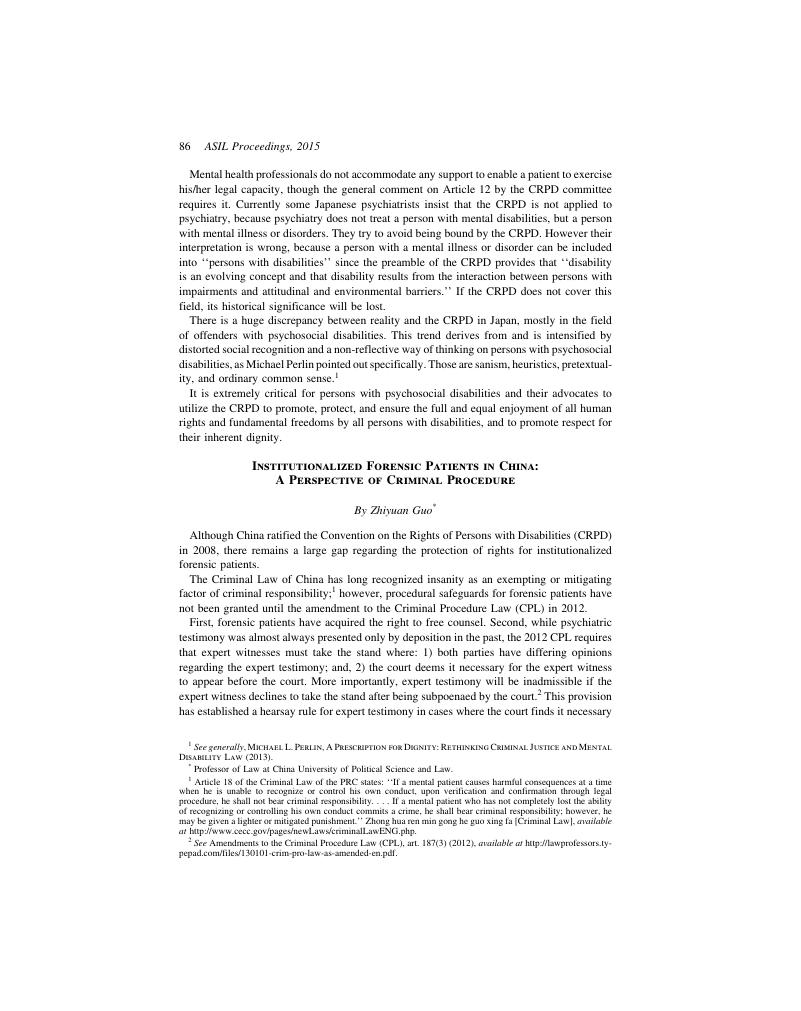Article contents
Institutionalized Forensic Patients in China: A Perspective of Criminal Procedure
Published online by Cambridge University Press: 20 January 2017
Abstract

- Type
- The Convention on the Rights of Persons with Disabilities and the Treatment of Institutionalized Forensic Patients
- Information
- Copyright
- Copyright © American Society of International Law 2016
References
1 Article 18 of the Criminal Law of the PRC states: “If a mental patient causes harmful consequences at a time when he is unable to recognize or control his own conduct, upon verification and confirmation through legal procedure, he shall not bear criminal responsibility. . . . If a mental patient who has not completely lost the ability of recognizing or controlling his own conduct commits a crime, he shall bear criminal responsibility; however, he may be given a lighter or mitigated punishment.” Zhong hua ren min gong he guo xing fa [Criminal Law], available at http://www.cecc.gov/pages/newLaws/criminalLawENG.php.
2 See Amendments to the Criminal Procedure Law (CPL), art. 187(3) (2012), available at http://lawprofessors.ty-pepad.com/files/130101-crim-pro-law-as-amended-en.pdf.
3 The psychiatric service system of China is institutionally complex. It is uncertain how many administrative systems (Xi Tong) have their own psychiatric facilities, but the great mass of mental health services are provided by four departments. The largest mental health service system is governed by the Ministry of Health and its local bureaus (accessible to urban and rural citizens who have health insurance, which covers their medical costs). The second largest is managed by local departments of the Ministry of Civil Affairs (serving those who are jobless or homeless and those whose families are otherwise too poor to pay for their care). The third largest belongs to the military, operating primarily for military personnel and their families. In recent years a number of these hospitals have begun providing care on a fee-for-service basis to local citizens. Finally, there is a system managed by the provincial or municipal departments of public security, called “Ankang Hospitals” that provide care for mentally ill criminal offenders. See Shao, Yang et al., Current Legislation on Admission of Mentally Ill Patients in China, 33 Int’l J. L. & Psychiatry 52 (2010)CrossRefGoogle ScholarPubMed.
4 Article 286 of the CPL provides: “When the people’s court admits an application for compulsory medical treatment, it should form a judicial panel for the hearing.”
5 CPL, supra note 2, art. 287.
6 Id. art. 289.
7 See Michaell.Perlin, International Human Rights and Mental Disability Law: When the Silenced Are Heard 34 (2011).
8 The Convention on the Rights of Persons with Disabilities provides: “States Parties shall ensure that if persons with disabilities are deprived of their liberty through any process, they are, on an equal basis with others, entitled to guarantees in accordance with international human rights law and shall be treated in compliance with the objectives and principles of this Convention, including by provision of reasonable accommodation “ (emphasis added). “Reasonable accommodation” means necessary and appropriate modification and adjustments not imposing a disproportionate or undue burden, where needed in a particular case, to ensure to persons with disabilities the enjoyment or exercise on an equal basis with others of all human rights and fundamental freedoms. See Convention on the Rights of Persons with Disabilities, G.A. Res. 61/106, U.N. Doc. A/RES/61/106, arts. 2, 14 (Dec. 13, 2006).
- 1
- Cited by




